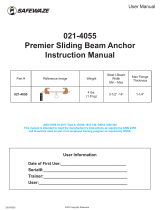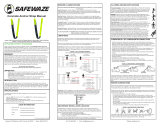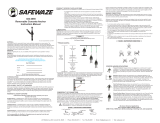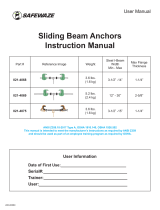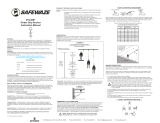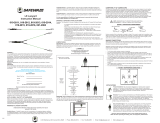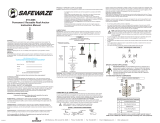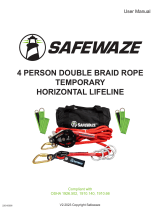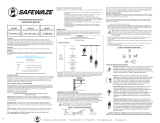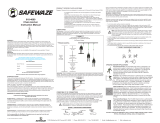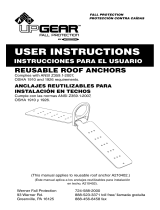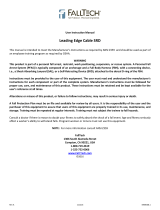La página se está cargando...

Address: 225 Wilshire Ave SW, Concord, NC 28025 Phone: 800-230-0319 Email: info@safewaze.com Website: safewaze.com Fax: 704-262-9051
I I
LIMITATIONS
Never exceed a free fall diance of 6 ft. A free fall of more than 6 ft. could cause excessive arre
forces that could result in serious injury or death.
Safewaze Anchors have a maximum capacity of ANSI 310 lbs./OSHA 420 lbs. including any
tools, clothing, accessories, etc., unless otherwise rated by Safewaze.
Structures for attachment of Safewaze Anchors shall support a minimum 5,000 lbs. (22 kN) or be
designed with a safety factor of two by a Qualied Person.
Fall Clearance: There must be sucient clearance below the anchorage connector to arrest a
fall before the user strikes the ground or an obstruction. When calculating fall clearance, account
for a MINIMUM 2’ safety factor, deceleration distance, user height, length of lanyard/SRL, and all
other applicable factors (Figure 1).
FIGURE 1: FALL CLEARANCE DIAGRAM
*This diagram is an example of fall clearance calculation ONLY.
Swing Falls: Prior to installation or use, make considerations for eliminating or minimizing all
swing fall hazards. Swing falls occur when the anchor is not directly above the location where
a fall occurs. Always work as close to, or in line with, the anchor point as possible. Swing falls
signicantly increase the likelihood of serious injury or death in the event of a fall (Figure 2).
FIGURE 2: SWING FALL
A
FALL-ARREST
S
W
I
N
G
F
A
L
L
Lanyard Length
(6’ Total)
Deceleration
Distance (3.5’ Total)
Height of Harness Dorsal
D-ring from
Worker’s Feet
(6’ Total)
Safety Factor
(2’ Total)
Required
Distance
from
Anchorage
(17.5’ Total)
For all applications, worker weight capacity range
(including all clothing, tools, and equipment) is
ANSI 130-310 lbs./OSHA up to 420 lbs.
WARNING:
The manufacturer’s instructions must be provided to users of this equipment. The user must
follow the manufacturer’s instructions for each component of the system. The user must read and
understand these instructions before using this equipment. Manufacturer’s instructions must be
followed for proper use and maintenance of this equipment. The user must understand how to
safely and eectively use the FS-EX310-1 ring anchor and all equipment used in conjunction with
the FS-EX310-1. Alterations to this product, misuse of this product, or failure to follow instructions
may result in serious injury or death. Avoid moving machinery, sharp and/or abrasive edges, and
any other hazard that could damage or degrade the component.
Do not throw away instructions!
Read and understand instructions before using equipment!
IMPORTANT:
• Questions regarding the use, care, or suitability of this equipment for your application?
Contact Safewaze.
• Only Safewaze, or entities authorized in writing by Safewaze, may make repairs to
Safewaze fall protection equipment.
• Record all important product information below prior to use. Documentation of all
Competent Person annual inspections is required in the Inspection Log.
FS-EX310-1
Ring Anchor
Manual
INTRODUCTION
Thank you for purchasing a Safewaze Anchorage Connector. This manual must be read and
understood in its entirety and used as part of an employee training program as required by
OSHA or any applicable state agency. This manual and any other instructional material must be
available to the user of the equipment. Every user must be trained in the inspection, installation,
operation, and proper usage of the anchor.
WORKER CLASSIFICATIONS
Read and understand the denitions of those who work in proximity of, or may be
exposed to, fall hazards:
Qualied Person: “Qualied Person” means one who, by possession of a recognized degree,
certicate, or professional standing, or who by extensive knowledge, training, and experience,
has successfully demonstrated their ability to solve or resolve problems relating to the subject
matter, the work, or the project.
Competent Person: “Competent Person” means one who is capable of identifying existing and
predictable hazards in the surroundings or working conditions which are unsanitary, hazardous,
or dangerous to employees, and who has authorization to take prompt corrective measures to
eliminate them.
Authorized Person: “Authorized Person” means a person approved or assigned by the
employer to perform a specic type of duty or duties, or to be at a specic location or locations,
at the jobsite.
It is the responsibility of a Qualied or Competent Person to supervise the jobsite and
ensure safety regulations are complied with.
APPLICABLE SAFETY STANDARDS
When used according to instructions, Safewaze Anchors meet ANSI Z359.18-2017 Type A and
OSHA 1910.140, 1926.502 regulations. Applicable standards and regulations depend on the
type of work being done and may include state-specic regulations. Refer to local, state, and
federal requirements for additional information on the governing of occupational safety regarding
Personal Fall Arrest Systems (PFAS).
The anchor connector has been tested in compliance with requirements of ANSI/ASSE Z359.7.
The testing does not extend to the substrate to which the anchorage connector is attached.
COMPATIBILITY OF COMPONENTS/CONNECTORS
• Unless otherwise noted, Safewaze equipment is designed for, and tested with, associated
Safewaze components or systems. Substitutions or replacements made with competitor’s
components or subsystems may jeopardize compatibility of equipment, possibly aecting
the safety and reliability of the overall system.
• Connectors are compatible with connecting elements when they have been designed
to work together in such a way that their sizes and shapes do not cause their gate
mechanisms to inadvertently open regardless of how they become oriented.
• Connectors (hooks, carabiners, and D-rings) must be capable of supporting at least 5,000
lbs. (22 kN).
• Connectors must be compatible with the anchorage or other system components.
• Do not use equipment that is not compatible. Non-compatible connectors may
unintentionally disengage (Figure 3).
• Connectors must be compatible in size, shape, and strength.
• Self-locking snap hooks and carabiners are required by ANSI Z359 and OSHA guidelines.
• Some specialty connectors have additional requirements. Contact Safewaze if you have
any questions about compatibility.
2. Gate Presses
Against
Non-Compliant Part
1. Non-Compliant Part 3. Gate Opens
4. Parts
Disengage
FIGURE 3: UNINTENTIONAL DISENGAGEMENT
Using a connector that is undersized or irregular in shape (1) to connect a snap hook or carabiner
could allow the connector to force open the gate of the snap hook or carabiner. When force is
applied, the gate of the hook or carabiner presses against the non-compliant part (2) and forces
open the gate (3). This allows the snap hook or carabiner to disengage (4) from the connection
point.
MAKING CONNECTIONS
Snap hooks and carabiners used with this equipment must be double locking and/or twist lock.
Ensure all connections are compatible in size, shape, and strength. Do not use equipment that is
not compatible. Ensure all connectors are fully closed and locked.
Safewaze connectors (hooks, carabiners, and D-rings) are designed to be used only as specied
in each product’s manual. See Figure 4 for examples of inappropriate connections. Do not
connect snap hooks and carabiners:
• To a D-ring to which another connector is attached.
• In a manner that would result in a load on the gate (with the exception of tie back hooks).
• In a false engagement, where features that protrude from the snap hook or carabiner
catch on the anchor, and without visual conrmation seems to be fully engaged to the
anchor point.
• To each other.
• By wrapping the web lifeline around an anchor and securing to lifeline, except as allowed
for tie back models.
• To any object which is shaped or sized in a way that the snap hook or carabiner will not
close and lock, or that roll-out could occur.
• In a manner that does not allow the connector to align properly while under load.
ANCHORAGE INSTALLATION LOCATION
A Qualied Person or Engineer must conduct an analysis of the workplace and anticipate where
workers will be performing their duties. An anchorage location selected for a PFAS must have a
strength capable of sustaining a static load applied in the direction permitted by the PFAS of at
least:
• Two times the maximum arrest force permitted when certication exists, or
• 5,000 lbs. (22kN) in the absence of certication.
Work Positioning: Safewaze Anchors are authorized for use in Work Positioning
applications. Work Positioning allows a worker to be supported during suspension while
freeing both hands to conduct work operations. The structure to which the Anchor is
attached must withstand loads applied in the directions permitted by the system of at
least 3,000 lbs. Maximum allowable free fall is 2 ft. For positioning applications, the
allowable attachment points to the harness are the Side D-rings.
Rescue/Conned Space: Safewaze Anchors are authorized for use in Rescue/Conned
Space applications. Rescue systems are utilized to safely recover a worker from a
conned location or after exposure to a fall. Composition of rescue systems can vary
based upon the type of rescue involved. The structure to which the Anchor is attached
must withstand loads applied in the directions permitted by the system of at least 3,100
lbs. NO free fall is permitted. For rescue applications, the allowable attachment points to
the harness are Dorsal D-ring, Front/Sternal D-ring, and Shoulder D-rings.
USER INFORMATION
Date of First Use: Trainer:
Serial Number: User:
SPECIFICATIONS
• Capacity: The FS-EX310-1 Ring Anchor is designed to provide a fall protection
anchorage for a single user with maximum weight of 420 lbs.
• The anchor is reusable.
• Three 5/16 in. x 3 in. Hex Lag Screws are included with the anchor.
• Length of anchor is 9’’.
• Minimum Breaking Strength is 5,000 lbs. (22kN).
• Minimum Service Temperature is -35°F (-37°C).
• 5,000 lbs. anchor point when used for Horizontal Lifeline (HLL) applications/single point
anchorage applications limited to a 30° work angle.
• 3,600 lbs. anchor point when used as a single point anchorage with 360° work
operations.
SPECIFIC ANCHOR APPLICATIONS
Personal Fall Arrest: Safewaze Anchors are designed as an anchor point to support a
maximum of 1 PFAS when utilized for fall protection applications. The structure to which
the anchor is attached must withstand loads applied in the directions permitted by the
system of at least 5,000 lbs. (22kN). Maximum allowable free fall is 6 ft. The allowable
attachment point to the harness is the Dorsal D-ring.
Restraint: Safewaze Anchors are authorized for use in Restraint applications. The
structure to which the anchor is attached must withstand loads applied in the directions
permitted by the system of at least 1,000 lbs. NO free fall is permitted. Restraint systems
may only be used on surfaces with slopes up to 4’’/12’’ (vertical / horizontal). For
Restraint applications, the allowable attachment points to the harness are Dorsal D-ring,
Front/Sternal D-ring, Side D-rings, and Shoulder D-rings.
FIGURE 4: INAPPROPRIATE CONNECTIONS
Large throat snap hooks must not be connected to standard size D-rings or similar objects which
will result in a load on the gate if the hook or D-ring twists or rotates, unless the snap hook
complies with ANSI Z359.1-2007 or ANSI Z359.12 and is equipped with a 3,600 lb. (16 kN) gate.

Address: 225 Wilshire Ave SW, Concord, NC 28025 Phone: 800-230-0319 Email: info@safewaze.com Website: safewaze.com Fax: 704-262-9051 II
FIGURE 7: APPROPRIATE USE
INSTALLATION
1. To install the FS-EX310-1 Ring Anchor, place the anchor on the truss with its at end pointed
down. The anchor should be installed as close to the ridge as possible. Utilize the (3) 5/16 in. x
3 in. Hex Lag Screws included. ALL screws and screw holes must be used. All fasteners must
be fully embedded into substrate to which they are attached. Minimum substrate thickness must
be 7/16 in. or greater, with fasteners attached through the roof substrate, with embedment into
truss (Figure 6).
2. The FS-EX310-1 can be reused and reinstalled. Fasteners can be reused if the pilot holes are
drilled prior to fastener installation. Pilot holes should be 7/32 in.
3. Prior to initial installation or subsequent removal and reinstallation, the user must ensure that
the FS-EX310-1 has no visible damage or defects. If removing and reinstalling the FS-EX310-1,
the user must ensure that no damage or warping has occurred due to prior installation or
removal. If any damage or defects are found the user must IMMEDIATELY remove the anchor
from service.
4. Once properly installed, the user may attach a complete and compatible Personal Fall Arrest
System to the O-Ring connection point on the FS-EX310-1.
FIGURE 6: INSTALLATION ILLUSTRATION
INSTALLATION PLANNING
The FS-EX310-1 Ring Anchor is designed to provide a fall protection anchorage for a single user.
It is designed for installation into wood roof material. The work location should be free of debris
and other materials or equipment that could interfere with the proper operation of this equipment.
Inspect the substrate to which the anchor will be attached. User should inspect the intended
installation location for hazards that include, but are not limited to, wood rot, severe weathering,
multiple layers of previously applied roong material, electrical hazards, etc.
Installation of the anchor is permitted over sheathing materials such as underlayment/
roong felt and shingles, provided the qualied engineer or Competent Person has
determined it is safe to do so and still maintains the proper safety factor.
WARNINGS
• Users should consult with their doctor to verify ability to safely absorb the forces of
a fall arrest event. Fitness level, age, and other health conditions can greatly aect
an individuals ability to withstand fall arrest forces. Women who are pregnant and
individuals considered minors must not use any Safewaze equipment.
• Anchors that are exposed to fall arrest forces MUST be IMMEDIATELY removed from
service and destroyed.
• Failure to follow these instructions and warnings could result in serious injury or death in
the event of a fall.
• A preplanned rescue procedure in the event of a fall is required. The rescue plan must be
specic to the project. The rescue plan must allow for employees to rescue themselves,
or to be promptly rescued by alternative means.
• Harnesses or connectors selected for use with any Safewaze anchor must be compatible
in size and conguration. User must ensure compatibility of snap hooks, carabiners, and
other connectors. Any connection which could allow disengagement must be eliminated.
Snap hooks and carabiners must be self-locking and self-closing and must never be
hooked to each other.
• A Competent Person must conduct an analysis of the workplace and anticipate where
workers will be conducting their duties, the route they will take to reach their work, and
the existing and potential fall hazards they may be exposed to. The Competent Person
must choose the fall protection equipment to be utilized.
• Equipment designated for fall protection must never be used to lift, hang, support, or
hoist tools or equipment unless specically certied for such use.
INSPECTION
• Safewaze Anchors shall be inspected prior to each use by the user.
• The anchor must be inspected at least annually by a Competent Person other than the
user.
• Competent person inspections must be recorded in the inspection log included in this
manual and on the inspection grid label on the anchor.
• Severity of conditions during use of anchor may necessitate increased frequency of
documented inspections.
• Anchors that fail inspection MUST be removed from service.
• Prior to each use, inspect the anchor for deciencies or damage including, but not limited
to, sharp edges, rough edges, deformations, corrosion, pits, burrs, chemical exposure,
extreme heat exposure, and damaged, missing, or illegible labels.
• If any deciencies or defects are found, the anchor must IMMEDIATELY be removed
from service.
LABELS
INSPECTION LOG
Inspection
Date:
Inspector: Pass/Fail: Comments/
Corrective Action:
INSPECTION LOG
ANNUAL FORM
MAINTENANCE / WARRANTY
The anchor can be cleaned with water and mild soap if necessary. The user should remove all
dirt, possible corrosives, and contaminants from the anchor prior to, and after, each use. Never
use any type of corrosive substance to clean the anchor. Excess water should be blown out with
compressed air. Hardware can be wiped o with a clean, dry cloth.
When not in use, store the anchor in a cool, dry area where it will not be exposed to extreme
light, extreme heat, excessive moisture, or corrosive chemicals/materials.
Safewaze warrants its products are free from defects in materials and construction under normal
use and service. Liability is not accepted for abuse, modication, improper use, destructive
activity and contaminated exposure.
SHEATHING
LAG BOLTS
TRUSS
JanFeb DecNovOctSepAugJul
JunMay
Apr
Mar
WARNING
This anchor must IMMEDIATELY be removed from service
if exposed to fall arrest forces. Avoid contact with sharp
and/or abrasive edges and surfaces. Avoid contact with
hazardous environments including but not limited to,
electrical, high temperatures, and corrosive chemicals.
WARNING
www.safewaze.com
Minimum Service Temp: -30° F
All connections must be
compatible
with the Ring Anchor.
Minimum Breaking Strength: 5,000 lbs (22.2kN)
Material: Steel
Meets: ANSI Z359.18-2017 Type A
OSHA 1910-1926
Year of MFG:_____ Serial #:________
User must follow
manufacturer’s instructions
included with this equipment
at the time of shipment from
the manufacturer. Refer to
the instruction manual for
proper installation and
limitations. Inspect prior to
each use.
USE: Installs over roof
sheathing into roof truss
using (3) 5/16” x 3”
hex lag screws.
FS-EX310-1
Ring Anchor
JanFeb DecNovOct
Sep
AugJul
JunMay
Apr
Mar
WARNING
This anchor must IMMEDIATELY be removed from service
if exposed to fall arrest forces. Avoid contact with sharp
and/or abrasive edges and surfaces. Avoid contact with
hazardous environments including but not limited to,
electrical, high temperatures, and corrosive chemicals.
WARNING
www.safewaze.com
Minimum Service Temp: -30° F
All connections must be
compatible
with the Ring Anchor.
Minimum Breaking Strength: 5,000 lbs (22.2kN)
Material: Steel
Meets: ANSI Z359.18-2017 Type A
OSHA 1910-1926
Year of MFG:_____ Serial #:________
User must follow
manufacturer’s instructions
included with this equipment
at the time of shipment from
the manufacturer. Refer to
the instruction manual for
proper installation and
limitations. Inspect prior to
each use.
USE: Installs over roof
sheathing into roof truss
using (3) 5/16” x 3”
hex lag screws.
FS-EX310-1
Ring Anchor
JanFeb DecNovOctSepAugJul
JunMay
Apr
Mar
WARNING
This anchor must IMMEDIATELY be removed from service
if exposed to fall arrest forces. Avoid contact with sharp
and/or abrasive edges and surfaces. Avoid contact with
hazardous environments including but not limited to,
electrical, high temperatures, and corrosive chemicals.
WARNING
www.safewaze.com
Minimum Service Temp: -30° F
All connections must be
compatible
with the Ring Anchor.
Minimum Breaking Strength: 5,000 lbs (22.2kN)
Material: Steel
Meets: ANSI Z359.18-2017 Type A
OSHA 1910-1926
Year of MFG:_____ Serial #:________
User must follow
manufacturer’s instructions
included with this equipment
at the time of shipment from
the manufacturer. Refer to
the instruction manual for
proper installation and
limitations. Inspect prior to
each use.
USE: Installs over roof
sheathing into roof truss
using (3) 5/16” x 3”
hex lag screws.
FS-EX310-1
Ring Anchor
30°
HORIZONTAL LIFELINE
SINGLE POINT ANCHORAGE
(30° WORK ANGLE)
5,000 lbs. Applications
JanFeb DecNovOct
Sep
AugJul
JunMay
Apr
Mar
WARNING
This anchor must IMMEDIATELY be removed from service
if exposed to fall arrest forces. Avoid contact with sharp
and/or abrasive edges and surfaces. Avoid contact with
hazardous environments including but not limited to,
electrical, high temperatures, and corrosive chemicals.
WARNING
www.safewaze.com
Minimum Service Temp: -30° F
All connections must be
compatible
with the Ring Anchor.
Minimum Breaking Strength: 5,000 lbs (22.2kN)
Material: Steel
Meets: ANSI Z359.18-2017 Type A
OSHA 1910-1926
Year of MFG:_____ Serial #:________
User must follow
manufacturer’s instructions
included with this equipment
at the time of shipment from
the manufacturer. Refer to
the instruction manual for
proper installation and
limitations. Inspect prior to
each use.
USE: Installs over roof
sheathing into roof truss
using (3) 5/16” x 3”
hex lag screws.
FS-EX310-1
Ring Anchor
360°
SINGLE POINT ANCHORAGE
(360° WORK RADIUS)
3,600 lbs. Applications
FIGURE 8: APPROPRIATE USE EXAMPLES
The FS-EX310-1 is suitable for us in HLL applications. For HLL systems with a capacity of up
to 2 users, both users may work on the same side of the roof peak. For HLL systems with a
capacity of up to 4 users, ensure that only 2 users are on each side of the roof peak. See Figure
8 (1-5) for examples of the anchor used in conjuction with HLL systems.
1
UP
2
UP
34
UP
5
FIGURE 5: ANCHOR COMPONENTS
Anchor Components Materials
A 5/16 in. x 3 in. Hex Lag Screws (3) Stainless Steel
BO-ring Zinc Plated Steel
CAnchor Plate Zinc Plated Steel
B
A
C

Website: safewaze.com Dirección: 225 Wilshire Ave SW, Concord, NC 28025 Teléfono: 800-230-0319
I Correo Electrónico info@safewaze.com Fax: 704-262-9051 I
LIMITACIONES
No exceda nunca 6 pies de caída libre. Las caídas libres de más de 6 pies pueden ejercer
fuerzas de parada excesivas que pueden causar lesiones graves o muerte.
Las anclas de Safewaze tienen una capacidad máxima de 310 lbs. conforme a las normas
del ANSI y 420 lbs. conforme a los reglamentos de la OSHA, incluyendo herramientas, ropa,
accesorios, etc., a menos que Safewaze determine otra cosa.
Las estructuras a las cuales se jen las anclas de Safewaze deben soportar un mínimo de
5000 lbs. (22 kN) o haber sido diseñadas con un factor de seguridad de dos por una persona
calicada.
Altura de caída: Debe haber suciente espacio debajo del conector de anclaje para parar una
caída antes de que el usuario se golpee contra el suelo o una obstrucción. Cuando calcule la
altura de caída, considere la distancia de desaceleración, la estatura del usuario, la longitud del
cordón o la SRL, un factor de seguridad de 2 pies como MÍNIMO, y todo otro factor aplicable
(Figura 1).
FIGURA 1: DIAGRAMA DE ALTURA DE CAÍDA
* Este diagrama es SOLO un ejemplo de cálculo de altura de caída.
Caídas pendulares: Antes de instalar o usar este equipo, elimine o minimice los riesgos de
caídas pendulares, que se producen cuando el punto de anclaje no está directamente encima
del punto de caída. Trabaje siempre lo más cerca posible de la vertical del punto de anclaje. Las
caídas pendulares aumentan signicativamente la probabilidad de lesiones graves o muerte
(Figura 2).
FIGURA 2: CAÍDA PENDULAR
A
FALL-ARREST
C
A
Í
D
A
P
E
N
D
U
L
A
R
Longitud del cordón
(6 pies)
Distancia de
desaceleración (3.5 pies)
Distancia entre el anillo
dorsal en D del arnés
y los pies del usuario
(6 pies)
Factor de seguridad
(2 pies)
Distancia
requerida
desde el
anclaje
(17.5 pies en
total)
En todas las conguraciones, la capacidad de peso de usuario de este equipo es de 130 a 310 lbs. conforme al
ANSI y 420 lbs. conforme a la OSHA (incluyendo herramientas, ropa y equipo).
ADVERTENCIA:
Las instrucciones del fabricante se le deben entregar al usuario de este equipo. El usuario
debe seguir las instrucciones del fabricante de cada componente del sistema. Antes de usar
este equipo, el usuario debe leer y entender estas instrucciones. El usuario debe seguir las
instrucciones del fabricante para usar y mantener correctamente este equipo. El usuario debe
entender cómo usar segura y efectivamente el ancla de anillo FS-EX301-1 y todo el equipo
de protección contra caídas que se usa con el ancla de anillo FS-EX301-1. Alterar o usar
incorrectamente este producto, o no seguir las instrucciones, puede causar lesiones graves o
muerte. Evite la maquinaria en movimiento, los bordes alados o abrasivos y todo otro peligro
que pueda dañar o degradar el componente.
¡No deseche estas instrucciones!
Antes de usar este equipo, el usuario debe leer y entender estas instrucciones.
IMPORTANTE:
• Si tiene dudas sobre el uso, cuidado o idoneidad de este equipo para sus propósitos,
comuníquese con Safewaze.
• Solo Safewaze, o las entidades autorizadas por escrito por Safewaze, pueden reparar el
equipo de protección contra caídas de Safewaze.
• Registre a continuación todos los datos importantes del producto antes de usarlo. Es
necesario documentar en el registro de inspecciones todas las inspecciones anuales
que haga la persona competente.
FS-EX310-1
Manual del ancla de anillo
DENOMINACIONES DE USUARIOS
Lea y entienda las denominaciones de las personas que se exponen a caídas o trabajan
cerca de estructuras que implican riesgo de caída.
Persona calicada: Persona con certicación, título homologado, prestigio profesional o
amplios conocimientos, capacitación y experiencia que ha demostrado su capacidad de resolver
problemas relacionados con el tema, el trabajo o el proyecto.
Persona competente: Persona capaz de identicar peligros conocidos y predecibles en
ambientes o condiciones de trabajo poco saludables o peligrosas para los empleados, y
autorizada a tomar medidas correctivas para eliminar dichos peligros.
Persona autorizada: Persona nombrada o aprobada por el empleador para llevar a cabo tareas
especícas o estar en lugares especícos de la obra.
Las personas calicadas o competentes son responsables de supervisar el lugar de
trabajo y garantizar que se cumplan las normas de seguridad.
COMPATIBILIDAD DE COMPONENTES O CONECTORES
• A menos que se indique otra cosa, el equipo de Safewaze ha sido diseñado y probado
con componentes o sistemas asociados de Safewaze. Las sustituciones o cambios por
componentes o subsistemas de la competencia pueden poner en peligro la compatibilidad del
equipo, lo cual puede a su vez afectar la seguridad y la conabilidad del sistema en general.
• Los conectores son compatibles con los elementos que se les conectan cuando han sido
diseñados para funcionar juntos de manera que su tamaño y su forma no causen la apertura
imprevista de los mecanismos de los cierres, independientemente de su orientación.
• Los conectores (ganchos, mosquetones y anillos en D) deben tener al menos 5000 lbs. (22
kN) de capacidad.
• Los conectores deben ser compatibles con el anclaje y los otros componentes del sistema.
• No use equipo incompatible. Los conectores incompatibles pueden desengancharse de
improviso (Figura 3).
• Los conectores deben ser compatibles en cuanto a tamaño, forma y capacidad.
• La norma ANSI Z359 y las directrices de la OSHA exigen ganchos de presión y mosquetones
de bloqueo automático.
• Algunos conectores especializados tienen requisitos adicionales. Comuníquese con Safewaze
si tiene preguntas sobre compatibilidad.
2 - El cierre
presiona la pieza
incompatible
1 - Pieza incompatible 3 - El cierre
se abre
4 - Las piezas se
desenganchan
FIGURA 3 - DESENGANCHE NO INTENCIONAL
Conectar un conector demasiado pequeño o de forma irregular (1) a un mosquetón o un gancho
de presión puede permitir que el conector abra el cierre del mosquetón o gancho de presión.
Cuando se ejerce fuerza, el cierre del mosquetón o del gancho presiona la pieza incompatible (2)
y se abre (3). Esto permite que el mosquetón o gancho de presión se desenganche (4).
FORMACIÓN DE CONEXIONES
Los mosquetones y ganchos de presión de este equipo deben tener cierre de bloqueo doble
y/o cierre giratorio. Todas las conexiones deben ser compatibles en cuanto a tamaño, forma
y capacidad. No use equipo incompatible. Todos los conectores deben estar completamente
cerrados y bloqueados.
Los conectores de Safewaze (mosquetones, ganchos de presión y anillos en D) deben usarse
solo como se especica en el manual de instrucciones de cada producto. En la Figura 4 hay
ejemplos de conexiones incorrectas. No conecte mosquetones o ganchos de presión:
• A un anillo en D al cual ya esté conectado otro conector.
• De una manera que ejerza fuerza sobre el cierre (excepto en caso de ganchos de sujeción).
• Con enganche falso, que se produce cuando las partes sobresalientes del mosquetón o
gancho de presión se enganchan en el ancla y, sin conrmación visual, dan la impresión de
que el mosquetón o gancho de presión está bien enganchado en el punto de anclaje.
• Uno a otro.
• Pasando la línea salvavidas de correa tejida alrededor del ancla y jándola a la línea
salvavidas, excepto según lo permitido para los modelos de sujeción.
• A objetos cuya forma o tamaño pueda causar una desconexión o impedir que el mosquetón o
gancho de presión se cierre y se bloquee.
• De una manera que impida la alineación correcta del conector cargado.
LUGAR DE INSTALACIÓN DEL ANCLAJE
Una persona calicada o un ingeniero debe analizar el espacio de trabajo y anticipar los lugares
en los cuales los usuarios van a llevar a cabo sus tareas. El punto de anclaje seleccionado para
un Sistema Personal de Parada de Caídas (Personal Fall Arrest System, PFAS) debe ser capaz
de soportar una carga estática aplicada en la dirección permitida por el PFAS de al menos:
• Dos veces la fuerza de parada máxima permitida cuando hay certicación, o
• 5000 lbs. (22 kN) cuando no hay certicación.
Posicionamiento de trabajo: Las anclas de Safewaze se pueden usar en conguraciones
de posicionamiento de trabajo, en las cuales el usuario es sostenido para que pueda trabajar
con las dos manos. La estructura a la cual se je el ancla de anillo FS-EX301-1 debe soportar
cargas de al menos 3000 lbs. aplicadas en las direcciones permitidas por el sistema. La
caída libre máxima permitida es de 2 pies. En conguraciones de posicionamiento, los puntos
de jación al arnés permitidos son los anillos laterales en D.
Rescate y espacio reducido: Las anclas de Safewaze se pueden usar en conguraciones
de rescate y espacio reducido. Los sistemas de rescate permiten recuperar con seguridad a
un usuario atrapado en un espacio reducido o suspendido en el aire después de una caída.
La composición del sistema de rescate depende del tipo de rescate. La estructura a la cual se
je el ancla de anillo FS-EX301-1 debe soportar cargas de al menos 3100 lbs. aplicadas en
las direcciones permitidas por el sistema. NO se permite la caída libre. En conguraciones de
rescate, los puntos de jación al arnés permitidos son el anillo dorsal en D, el anillo pectoral en D
y los anillos en D de los hombros.
DATOS DEL USUARIO
Fecha de la 1.a vez que usó el equipo: Capacitador:
N.º de serie: Usuario:
CONFIGURACIONES ESPECÍFICAS DE ANCLAJE
Parada de caída personal: Las anclas de Safewaze han sido diseñadas como puntos de
anclaje que soportan un máximo de un (1) Sistema Personal de Parada de Caídas (Personal
Fall Arrest System, PFAS) en conguraciones de protección contra caídas. La estructura a la
cual se je el ancla de anillo FS-EX301-1 debe soportar cargas de al menos 5000 lbs. (22 kN)
aplicadas en las direcciones permitidas por el sistema. La caída libre máxima permitida es de
6 pies. El punto de jación al arnés permitido es el anillo dorsal en D.
Restricción: Las anclas de Safewaze se pueden usar en conguraciones de restricción. La
estructura a la cual se je el ancla de anillo FS-EX301-1 debe soportar cargas de al menos
1000 lbs. aplicadas en las direcciones permitidas por el sistema. NO se permite la caída libre.
Los sistemas de restricción se pueden usar solo en supercies con pendientes de hasta
4” / 12” (vertical / horizontal). En conguraciones de restricción, los puntos de jación al arnés
permitidos son el anillo dorsal en D, el anillo pectoral en D, los anillos laterales en D y los
anillos en D de los hombros.
FIGURA 4 - CONEXIONES INCORRECTAS
No se deben conectar ganchos de presión grandes a anillos en D de tamaño estándar u objetos
similares que se apoyarían en el cierre si el gancho o el anillo en D se torciera o girara, a menos
que el gancho de presión cumpla con la norma ANSI Z359.1-2007 o la norma ANSI Z359.12 y
tenga un cierre de 3600 lbs. (16 kN) de capacidad.
1 Sociedad Estadounidense de Profesionales de Seguridad (American Society of Safety Professionals, ASSP)
NORMAS DE SEGURIDAD APLICABLES
Cuando se usan conforme a las instrucciones, las anclas de Safewaze satisfacen las normas
Z359.18-2017 Tipo A del Instituto Nacional Estadounidense de Normas (American National
Standards Institute, ANSI) y los reglamentos 1910.140, 1926.502 de la Ley de Salud y
Seguridad Ocupacional (Occupational Safety and Health Act, OSHA). Las normas y los
reglamentos aplicables dependen del tipo de trabajo que se está haciendo y pueden incluir
reglamentos estatales especícos. Consulte los requisitos locales, estatales y federales para
ver más información sobre los reglamentos de seguridad ocupacional que rigen los Sistemas
Personales de Parada de Caídas (Personal Fall Arrest Systems, PFAS).
El conector de anclaje ha sido puesto a prueba según los requisitos de la norma Z359.7 del
ANSI/ASSP.1 La prueba no se extiende al sustrato en el cual se ja el conector de anclaje.
INTRODUCCIÓN
Gracias por comprar un conector de anclaje de Safewaze. El usuario debe leer y entender
todo este manual, que debe formar parte de un programa de capacitación del usuario según
lo requerido por la OSHA o las agencias estatales correspondientes. Este manual y todo otro
material de enseñanza deben estar siempre a disposición del usuario del equipo. Todo usuario
debe estar capacitado para inspeccionar, instalar, hacer funcionar y usar correctamente el ancla.
ESPECIFICACIONES
• Capacidad: El ancla de anillo FS-EX310-1 ha sido diseñada como anclaje de protección
contra caídas para un solo usuario con un peso máximo de 420 libras.
• El ancla es reutilizable.
• El ancla trae tres tirafondos hexagonales de 5/16 plg. x 3 plg.
• El ancla tiene 9 plg. de largo
• La resistencia mínima a la rotura es de 5000 lbs. (22 kN).
• La temperatura mínima de servicio es -35 °F (-37 °C).
• En conguraciones de Línea Salvavidas Horizontal (Horizontal Lifeline, HLL) y
conguraciones de punto de anclaje único, el anclaje tiene una capacidad de 5000 lbs. y un
ángulo máximo de trabajo de 30°.
• En conguraciones de punto de anclaje único, el anclaje tiene una capacidad de 3600 lbs. y
un ángulo máximo de trabajo de 360°.

Website: safewaze.com Dirección: 225 Wilshire Ave SW, Concord, NC 28025 Teléfono 800-230-0319
I
Correo Electrónico info@safewaze.com Fax: 704-262-9051 I
FIGURA 7: USO CORRECTO
INSTALACIÓN
1. Ubique el ancla de anillo FS-EX310-1 sobre la viga con el extremo plano hacia abajo. El
ancla se debe instalar lo más cerca posible del caballete con los (3) tirafondos hexagonales de
5/16 plg. x 3 plg. incluidos. Se deben usar TODOS los tornillos y oricios para tornillos. Todos
los jadores deben entrar completamente en el sustrato en cual se jan. El grosor mínimo del
sustrato debe ser de 7/16 pulgadas y los jadores se deben jar en la viga de techo a través del
sustrato del techo (Figura 6).
2. La FS-EX310-1 se puede volver a usar e instalar. Los jadores se pueden volver a usar si se
hacen agujeros piloto antes de instalarlos. Los agujeros piloto deben ser de 7/32 plg.
3. Antes de la instalación inicial o la posterior extracción y reinstalación, el usuario debe
asegurarse de que la FS-EX310-1 no presente daños ni defectos visibles. Si retira y reinstala
la FS-EX310-1, el usuario debe asegurarse de que no se haya producido ningún daño o
deformación debido a la instalación o extracción previa. Si encuentra daños o defectos, el
usuario debe poner el ancla INMEDIATAMENTE fuera de servicio.
4. Una vez que el ancla ha sido instalada correctamente, el usuario puede conectar un sistema
personal de parada de caídas completo y compatible al anillo de la FS-EX310-1.
FIGURA 6: INSTALACIÓN
PLANIFICACIÓN DE LA INSTALACIÓN
El ancla de anillo FS-EX310-1 ha sido diseñada como anclaje de protección contra caídas para
un solo usuario.
Esta ancla debe instalarse en material de techo de madera. En el lugar de trabajo no debe haber
desechos, materiales o equipos que puedan interferir con la instalación o el funcionamiento
correcto de este equipo.
El usuario debe inspeccionar el sustrato en el cual se va a jar el ancla para detectar los siguientes
peligros, entre otros: putrefacción de la madera, deterioro grave debido a la intemperie, varias
capas de material de techado previamente instalado, instalaciones eléctricas, etc.
El ancla se puede instalar sobre materiales de revestimiento tales como contrapiso o
eltro para techos y tejas, siempre que un ingeniero calicado o una persona competente
haya determinado que es seguro hacerlo y que se conserve el factor de seguridad
apropiado.
ADVERTENCIAS
• El usuario debe consultar al médico para vericar su capacidad de absorber con
seguridad las fuerzas de una parada de caída. La edad, el estado físico y otras
características de salud afectan en gran medida la capacidad de soportar caídas. Ni los
menores de edad ni las mujeres embarazadas deben usar equipo de Safewaze.
• Las anclas de Safewaze expuestas a fuerzas de parada de caída DEBEN ponerse fuera
de servicio INMEDIATAMENTE y luego deben ser destruidas.
• No seguir estas instrucciones y no respetar estas advertencias puede causar lesiones
graves o muerte en caso de caída.
• Se requiere un plan de rescate establecido de antemano para casos de caída. El plan de
rescate debe corresponder al proyecto. El plan de rescate debe permitir que el usuario
se rescate a sí mismo o sea rescatado rápidamente por otros medios.
• Los arneses y conectores seleccionados para las anclas de Safewaze deben ser
compatibles en cuanto a tamaño y conguración. Se deben seleccionar y congurar
mosquetones, ganchos de presión y otros conectores mutuamente compatibles. Se
debe eliminar toda conexión que permitiría el desenganche. Los mosquetones y
ganchos de presión deben ser de bloqueo y cierre automático y no deben engancharse
nunca entre sí.
• Una persona competente debe analizar el área de trabajo y anticipar los lugares en que
los usuarios llevarán a cabo sus tareas, la ruta que seguirán para llegar a su lugar de
trabajo y los riesgos de caída presentes y posibles a los que se pueden exponer. La
persona competente debe escoger el equipo de protección contra caídas.
• El equipo destinado a protección contra caídas no debe usarse nunca para levantar,
colgar, soportar o izar herramientas o equipo, a menos que haya sido especícamente
certicado para eso.
INSPECCIÓN
l Las anclas de Safewaze deben ser inspeccionadas por el usuario nal cada vez que se
van a usar.
l El ancla debe ser inspeccionada por una persona competente que no sea el usuario al
menos una vez al año.
l Las inspecciones llevadas a cabo por la persona competente se deben anotar en el
registro de inspecciones de este manual y en la cuadrícula de inspección de la etiqueta
del ancla.
l La intensidad de las condiciones de uso puede requerir una mayor frecuencia de
inspecciones documentadas.
l Las anclas que no pasen la inspección se DEBEN poner fuera de servicio.
l Cada vez que vaya a usar el ancla, inspecciónela para ver si tiene deciencias o daños
tales como, entre otros, bordes alados, bordes ásperos, deformaciones, corrosión,
picaduras, rebabas, señales de exposición a productos químicos o calores extremos; o
etiquetas, dañadas, perdidas o ilegibles.
l Si se encuentran deciencias o defectos, el ancla debe ponerse INMEDIATAMENTE
fuera de servicio.
ETIQUETAS
REGISTRO DE INSPECCIONES
REGISTRO DE INSPECCIONES
FORMULARIO ANUAL
Fecha de Inspector: Comentarios /
inspección Medidas correctivas
APROBADO
RECHAZADO
MANTENIMIENTO Y GARANTÍA
El ancla se puede lavar con agua y jabón suave si es necesario. El usuario debe quitarle la
suciedad, los contaminantes y las sustancias posiblemente corrosivas cada vez antes y después
de usarla. No limpie nunca el ancla con ningún tipo de sustancia corrosiva. El exceso de agua se
debe retirar con aire comprimido. Los herrajes se pueden limpiar con un paño limpio y seco.
Cuando no la esté usando, guarde el ancla en un lugar fresco y seco donde no quede expuesta
a extremos de luz, calor o humedad, o a materiales o productos químicos posiblemente
corrosivos.
Safewaze garantiza que sus productos carecen de defectos de materiales o fabricación y que
funcionan correctamente en condiciones normales de uso y servicio. Safewaze no acepta
responsabilidad por abuso, modicación, uso indebido, actividad destructiva o exposición a la
contaminación.
www.safewaze.com
Resistencia mínima a la rotura: 5000 lbs. / 22.2 kN
Material: Acero
Cumple con ANSI Z359.18-2017 Tipo A y
OSHA 1910-1926
Año de fabricación: ________
N.º de serie: ____________
Ancla de anillo
FS-EX310-1
ADVERTENCIA
El usuario debe seguir las instruc-
ciones del fabricante que vienen con
el equipo. En el manual de
instrucciones hay información
sobre instalación correcta y
limitaciones. Inspeccione el ancla
cada vez que la vaya a usar.
MODO DE EMPLEO: Instale el
ancla con 3 tirafondos grado 5
#12 de 3 plg., atornillados en
la viga de techo a través de
la cubierta del techo.
Temperatura mínima de
servicio: -30 °F.
Todas las conexiones
deben ser compatibles
con el ancla de anillo.
ADVERTENCIA
Esta ancla debe ponerse fuera de servicio INMEDIATAMENTE si
es sometida a fuerzas de parada de caída. Evite el contacto con
bordes afilados y superficies abrasivas. Evite la exposición a
factores peligrosos tales como, entre otros, altas temperaturas,
electricidad y productos químicos corrosivos.
Ene. Feb. Mar. Abr. May. Jun. Jul. Ago. Sep. Oct. Nov. Dec.
CUBIERTA
TIRA FONDOS
VIGA
JanFeb Dec
Nov
OctSep
Aug
Jul
Jun
May
Apr
Mar
WARNING
This anchor must IMMEDIATELY be removed from service
if exposed to fall arrest forces. Avoid contact with sharp
and/or abrasive edges and surfaces. Avoid contact with
hazardous environments including but not limited to,
electrical, high temperatures, and corrosive chemicals.
WARNING
www.safewaze.com
Minimum Service Temp: -30° F
All connections must be
compatible
with the Ring Anchor.
Minimum Breaking Strength: 5,000 lbs (22.2kN)
Material: Steel
Meets: ANSI Z359.18-2017 Type A
OSHA 1910-1926
Year of MFG:_____ Serial #:________
User must follow
manufacturer’s instructions
included with this equipment
at the time of shipment from
the manufacturer. Refer to
the instruction manual for
proper installation and
limitations. Inspect prior to
each use.
USE: Installs over roof
sheathing into roof truss
using (3) 5/16” x 3”
hex lag screws.
FS-EX310-1
Ring Anchor
JanFeb Dec
NovOct
SepAugJul
JunMay
Apr
Mar
WARNING
This anchor must IMMEDIATELY be removed from service
if exposed to fall arrest forces. Avoid contact with sharp
and/or abrasive edges and surfaces. Avoid contact with
hazardous environments including but not limited to,
electrical, high temperatures, and corrosive chemicals.
WARNING
www.safewaze.com
Minimum Service Temp: -30° F
All connections must be
compatible
with the Ring Anchor.
Minimum Breaking Strength: 5,000 lbs (22.2kN)
Material: Steel
Meets: ANSI Z359.18-2017 Type A
OSHA 1910-1926
Year of MFG:_____ Serial #:________
User must follow
manufacturer’s instructions
included with this equipment
at the time of shipment from
the manufacturer. Refer to
the instruction manual for
proper installation and
limitations. Inspect prior to
each use.
USE: Installs over roof
sheathing into roof truss
using (3) 5/16” x 3”
hex lag screws.
FS-EX310-1
Ring Anchor
Jan
Feb Dec
Nov
OctSep
Aug
Jul
Jun
May
Apr
Mar
WARNING
This anchor must IMMEDI
ATELY be removed from service
if exposed to fall arrest forces.
Avoid contact with sharp
and/or abrasive edges and surfaces.
Avoid contact with
hazardous environments including but not limited to,
electrical, high temperatures, and corrosive chemicals.
WARNING
www.safewaze.com
Minimum Service Temp: -30° F
All connections must be
compatible
with the Ring Anchor.
Minimum Breaking Strength: 5,000 lbs (22.2kN)
Material: Steel
Meets:
ANSI Z359.18-2017
Type A
OSHA 1910-1926
Y
ear of MFG:_____ Serial #:________
User must follow
manufacturer’s instructions
included with this equipment
at the time of shipment from
the manufacture
r. Refer to
the instruction manual for
proper installation and
limitations. Inspect
prior to
each use.
USE: Installs over roof
sheathing into roof truss
using (3) 5/16” x 3”
hex lag screws.
FS-EX310-1
Ring Anchor
30°
LÍNEA SALVAVIDAS HORIZONTAL
PUNTO DE ANCLAJE ÚNICO
(ÁNGULO DE TRABAJO DE 30°)
Conguraciones de 5000 lbs.
JanFeb DecNovOct
Sep
Aug
Jul
JunMay
Apr
Mar
WARNING
This anchor must IMMEDIATELY be removed from service
if exposed to fall arrest forces. Avoid contact with sharp
and/or abrasive edges and surfaces. Avoid contact with
hazardous environments including but not limited to,
electrical, high temperatures, and corrosive chemicals.
WARNING
www.safewaze.com
Minimum Service Temp: -30° F
All connections must be
compatible
with the Ring Anchor.
Minimum Breaking Strength: 5,000 lbs (22.2kN)
Material: Steel
Meets: ANSI Z359.18-2017 Type A
OSHA 1910-1926
Year of MFG:_____ Serial #:________
User must follow
manufacturer’s instructions
included with this equipment
at the time of shipment from
the manufacturer. Refer to
the instruction manual for
proper installation and
limitations. Inspect prior to
each use.
USE: Installs over roof
sheathing into roof truss
using (3) 5/16” x 3”
hex lag screws.
FS-EX310-1
Ring Anchor
360°
PUNTO DE ANCLAJE ÚNICO
(ÁNGULO DE TRABAJO DE 360°)
Conguraciones de 3600 lbs.
FIGURA 8: EJEMPLOS DE USO CORRECTO
La FS-EX310-1 sirve para conguraciones de Línea Salvavidas Horizontal (Horizontal Lifeline,
HLL). En sistemas de HLL con capacidad de hasta 2 usuarios, ambos usuarios pueden trabajar
en el mismo lado de la cumbrera del techo. En sistemas de HLL con capacidad de hasta 4
usuarios, solo 2 usuarios pueden encontrarse simultáneamente a cada lado de la cumbrera. En
la Figura 8 (1-5) se muestran ejemplos de uso del ancla en sistemas de HLL.
1
UP
2
UP
34
UP
5
FIGURA 5 - COMPONENTES DEL ANCLA
Componentes del ancla Materiales
ATirafondos hexagonales de 5/16 plg.
x 3 plg. (3) Acero inoxidable
B Anillo Acero zincado
C Placa de ancla Acero zincado
B
A
C
1/4
